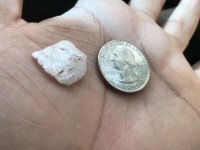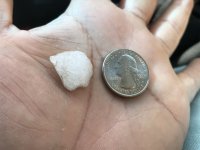Navigation
Install the app
How to install the app on iOS
Follow along with the video below to see how to install our site as a web app on your home screen.
Note: This feature may not be available in some browsers.
More options
You are using an out of date browser. It may not display this or other websites correctly.
You should upgrade or use an alternative browser.
You should upgrade or use an alternative browser.
Native American Artifact? Point ?
- Thread starter 8Reales
- Start date
- Jul 27, 2006
- 49,429
- 57,652
- Detector(s) used
- Minelab_Equinox_ 800 Minelab_CTX-3030 Minelab_Excal_1000 Minelab_Sovereign_GT Minelab_Safari Minelab_ETrac Whites_Beach_Hunter_ID Fisher_1235_X
- Primary Interest:
- All Treasure Hunting
Pictures are not the best so very hard to see the edges, looks likw quartz which is hard to work, I wouldn't say point, it looks like either maybe a thumb scraper or a piece of debitage but with out better pictures it is hard to say, especially since it is quartz, it could just be natural rock. Just an FYI, if you want opinions on a possible artifact always post best pictures possible of all sides, top bottom and the edges so members can see and are able to give better opinions based on what close up pictures reveal.
8Reales
Bronze Member
- Thread starter
- #3
Here are some other pics
Hard to take pics
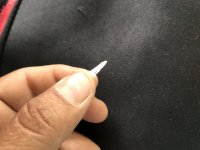
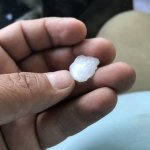
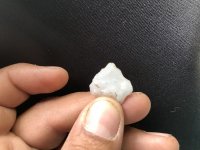
Hard to take pics



Pictures are not the best so very hard to see the edges, looks likw quartz which is hard to work, I wouldn't say point, it looks like either maybe a thumb scraper or a piece of debitage but with out better pictures it is hard to say, especially since it is quartz, it could just be natural rock. Just an FYI, if you want opinions on a possible artifact always post best pictures possible of all sides, top bottom and the edges so members can see and are able to give better opinions based on what close up pictures reveal.
Fat
Bronze Member
- Oct 22, 2020
- 2,191
- 6,888
- Detector(s) used
- I took the battery out because I like my bacon crispy
- Primary Interest:
- Other
It does look like the correct quartz lithic that is found in that area. Sometimes with that material when they broke, they literally came apart.
Keep it, find more lay them out on a shelf and soon you will have your own reference.
I think more local knowledge will give there thoughts too.
Keep it, find more lay them out on a shelf and soon you will have your own reference.
I think more local knowledge will give there thoughts too.
8Reales
Bronze Member
- Thread starter
- #5
Agree on the quarts ID, but I’m leaning towards the natural piece option
It does look like the correct quartz lithic that is found in that area. Sometimes with that material when they broke, they literally came apart.
Keep it, find more lay them out on a shelf and soon you will have your own reference.
I think more local knowledge will give there thoughts too.
Tdog
Silver Member
I think the key to IDing quartz artifacts is learning how to recognize the flaking scars. They have a distinct look even on low quality, sugary, mineralized quartzite but quite the opposite on a good tool grade of quartz. I cannot determine whether you have an artifact from your pics. If I were you, I'd start pitching pieces like that in a common location whether on the ground somewhere or in a container. When you've been in the hobby for a while, you'll probably want to look them over again. Keep the enthusiasm and keep looking DOWN! 

8Reales
Bronze Member
- Thread starter
- #7
I think the key to IDing quartz artifacts is learning how to recognize the flaking scars. They have a distinct look even on low quality, sugary, mineralized quartzite but quite the opposite on a good tool grade of quartz. I cannot determine whether you have an artifact from your pics. If I were you, I'd start pitching pieces like that in a common location whether on the ground somewhere or in a container. When you've been in the hobby for a while, you'll probably want to look them over again. Keep the enthusiasm and keep looking DOWN!
Will definitely hold on to it for future reference
We get a lot of quartz artifacts in MA, and that definitely looks like the type of thing that I’d pick up. Flaking can be hard to spot on quartz, but the wavy/crenellated edge is a good sign of working. It’s likely a debitage flake or scraper.
8Reales
Bronze Member
- Thread starter
- #9
We get a lot of quartz artifacts in MA, and that definitely looks like the type of thing that I’d pick up. Flaking can be hard to spot on quartz, but the wavy/crenellated edge is a good sign of working. It’s likely a debitage flake or scraper.
Thank you for your input
Top Member Reactions
-
 3469
3469 -
 2075
2075 -
 1984
1984 -
 1151
1151 -
 1142
1142 -
 923
923 -
 837
837 -
 811
811 -
 804
804 -
 788
788 -
 747
747 -
 530
530 -
 482
482 -
 467
467 -
 445
445 -
 422
422 -
E
416
-
 416
416 -
 413
413 -
 398
398
Users who are viewing this thread
Total: 2 (members: 0, guests: 2)
